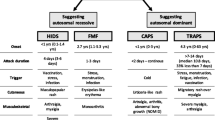Abstract
The hyperimmunoglobulinemia D and periodic fever syndrome (HIDS) is an autoinflammatory syndrome. It is caused by the mutations of the mevalonate kinase gene. There is no consensus for specific therapy of HIDS, but there are some case reports and studies in regards to its treatment with drugs like colchicine, steroids, nonsteroid anti-inflammatory drugs, simvastatin, anakinra, thalidomide, and etanercept. We are reporting a case evaluated for the complaints of abdominal pain and febrile episodes with massive hepatomegaly, not common finding on physical examination, its treatment with etanercept, and long-term follow-up.
Similar content being viewed by others
Abbreviations
- HIDS:
-
hyperimmunoglobulinemia D and periodic fever
- MVK:
-
mevalonate kinase
- Hct:
-
hematocrit
- AST:
-
aspartate amino transferase
- ALT:
-
alanine amino transferase
- CT:
-
computerized tomography
- ESR:
-
erythrocyte sedimentation rate
- MEFV:
-
Mediterranean fever
- SAA:
-
serum amyloid A
- Anti-TNF:
-
antitumor necrosing factor
- HMG-CoA:
-
3’-hydroxy-3’-methylglutarylcoenzyme A
- IL-1:
-
interleukin-1
References
Drenth JP, Cuisset L, Grateau G et al (1999) Mutations in the gene encoding mevalonate kinase cause hyper-IgD and periodic fever syndrome. International Hyper-IgD Study Group. Nat Genet 22:178–181
Drenth JP, Denecker NE, Prieur AM et al (1995) Hyperimmunoglobulin D syndrome. Presse Med 24:1211–1213
Drenth JP, Haagsma CJ, van der Meer JM (1994) Hyperimmunoglobulinemia D and periodic fever syndrome. The clinical spectrum in a series of 50 patients. International Hyper-IgD Study Group. Medicine (Baltimore) 73:133–144
de Dios Garcia D, varez-Blanco MJ (2001) Glucocorticoids but not NSAID abort attacks in hyper-IgD and periodic fever syndrome. J Rheumatol 28:925–926
Simon A, Drewe E, van der Meer JW et al (2004) Simvastatin treatment for inflammatory attacks of the hyperimmunoglobulinemia D and periodic fever syndrome. Clin Pharmacol Ther 75:476–483
Drenth JP, Vonk AG, Simon A et al (2001) Limited efficacy of thalidomide in the treatment of febrile attacks of the hyper-IgD and periodic fever: a randomized, double-blind, placebo-controlled trial. J Pharmacol Exp Ther 298(3):1221–1226
Bodar EJ, van der Hilst JC, Drenth JP et al (2005) Effect of etanercept and anakinra on inflammatory attacks in the hyper-IgD syndrome: introducing a vaccination provocation model. Neth J Med 63(7):260–264
Drenth JP, van Deuren M, van der Ven-Jongekrijg J et al (1995) Cytokine activation during attacks of the hyperimmunoglobulinemia D and periodic fever syndrome. Blood 85(12):3586–3593
Arkwright PD, McDermott MF, Houten SM et al (2002) Hyper IgD syndrome (HIDS) associated with in vitro evidence of defective monocyte TNFRSF1A shedding and partial response to TNF receptor blockade with etanercept. Clin Exp Immunol 130(3):484–488
Demirkaya E, Çağlar MK, Waterham HR et al (2007) A patient with hyper-IgD syndrome responding to anti-TNF treatment. Clin Rheumatol 26:1757–1759
Topaloğlu R, Saatçi Ü (1991) Hyperimmunoglobulinemia D and periodic fever mimicking familial Mediterranean fever in the Mediterranean. Postgrad Med J 67(787):490–491
Çoban E, Terzioğlu E (2004) A patient with hyper-IgD syndrome in Antalya, Turkey. Clin Rheumatol 23:177–178
Mandey SHL, Schneiders MS, Koster J et al (2006) Mutational spectrum and genotype phenotype correlations in mevalonate kinase deficiency. Hum Mutat 27(8):796–802
Rabinovich E, Livneh A, Langevitz P et al (2005) Severe disease in patients with rheumatoid arthritis carrying a mutation in the Mediterranean fever gene. Ann Rheum Dis 64(7):1009–1014
Hinson DD, Rogers ZR, Hoffmann GF et al (1998) Hematological abnormalities and cholestatic liver disease in two patients with mevalonate kinase deficiency. Am J Med Genet 88:408–412
Disclosures
None
Author information
Authors and Affiliations
Corresponding author
Rights and permissions
About this article
Cite this article
Topaloğlu, R., Ayaz, N.A., Waterham, H.R. et al. Hyperimmunoglobulinemia D and periodic fever syndrome; treatment with etanercept and follow-up. Clin Rheumatol 27, 1317–1320 (2008). https://doi.org/10.1007/s10067-008-0911-3
Received:
Revised:
Accepted:
Published:
Issue Date:
DOI: https://doi.org/10.1007/s10067-008-0911-3



